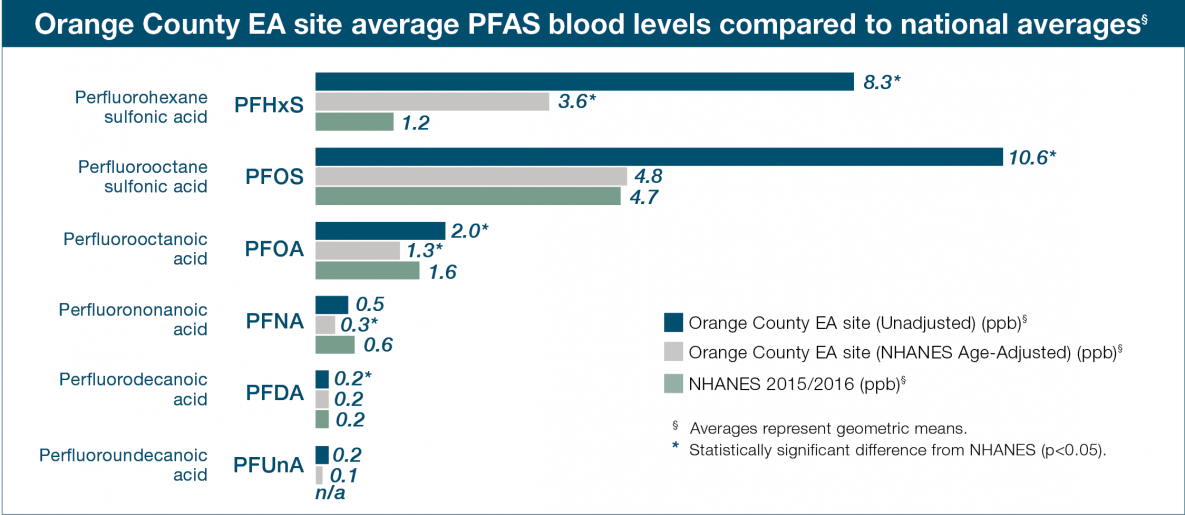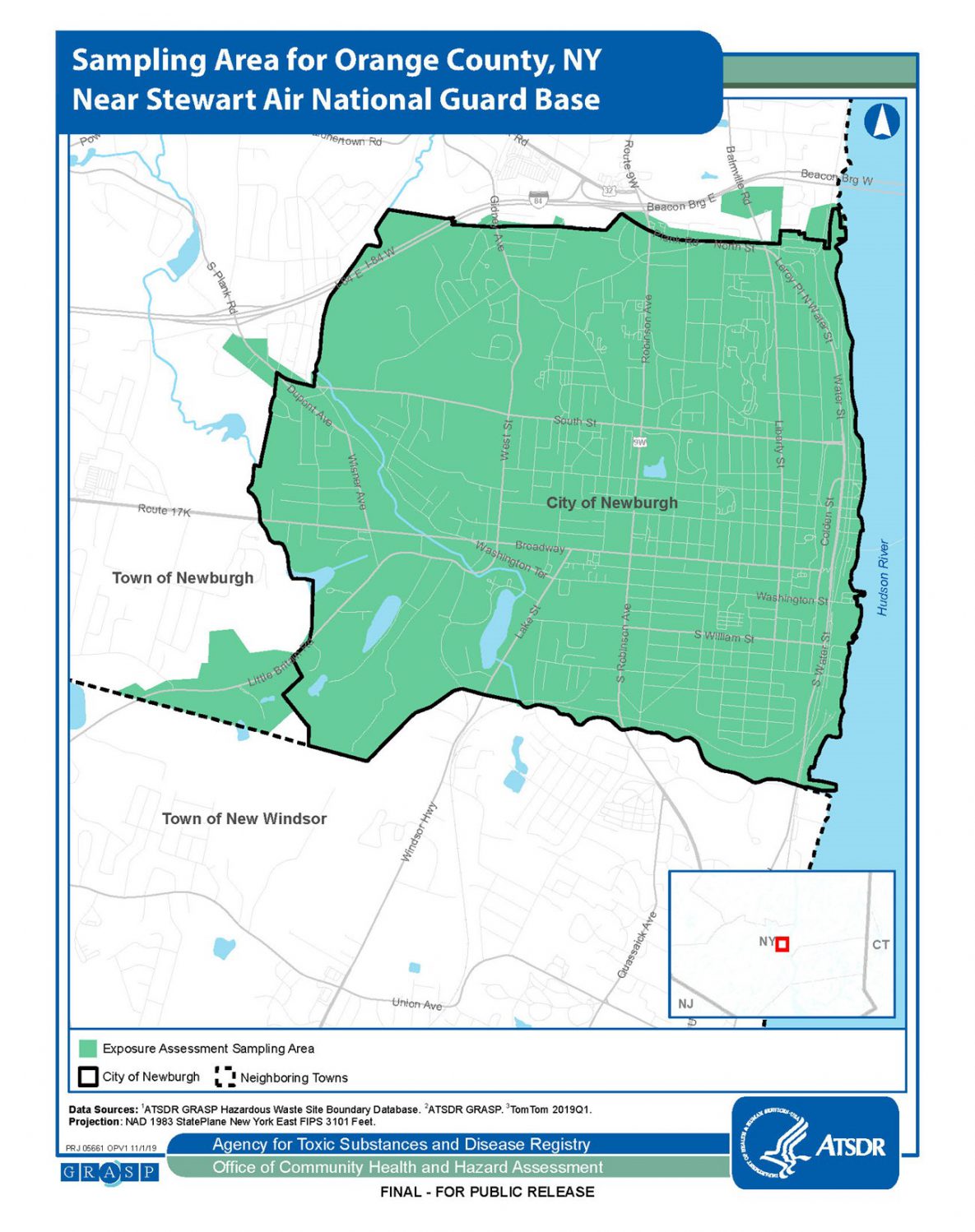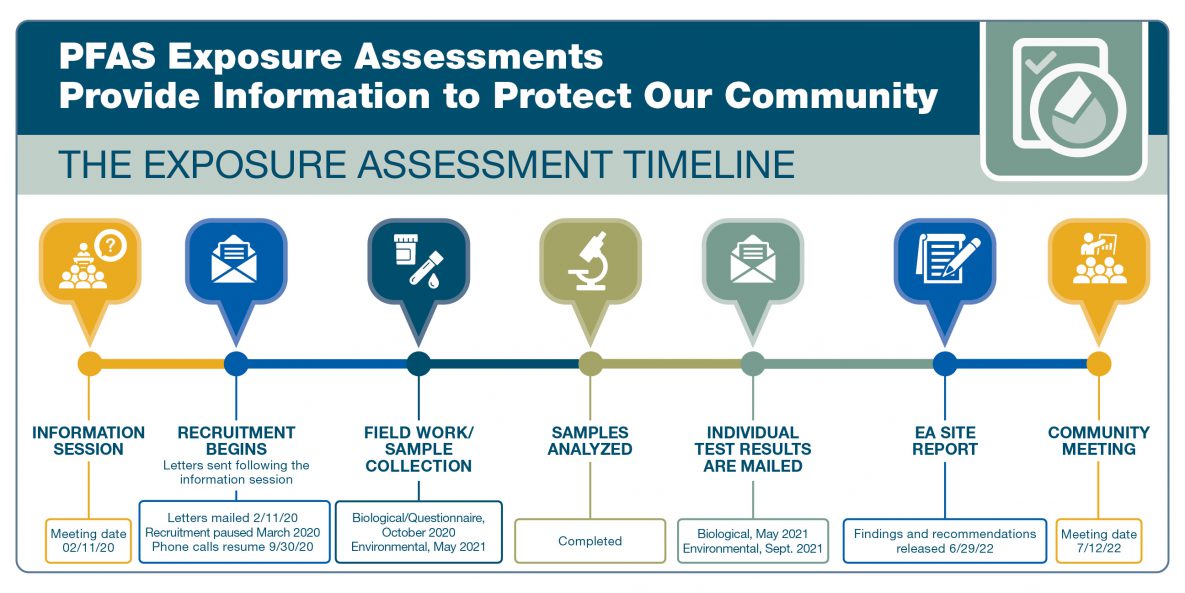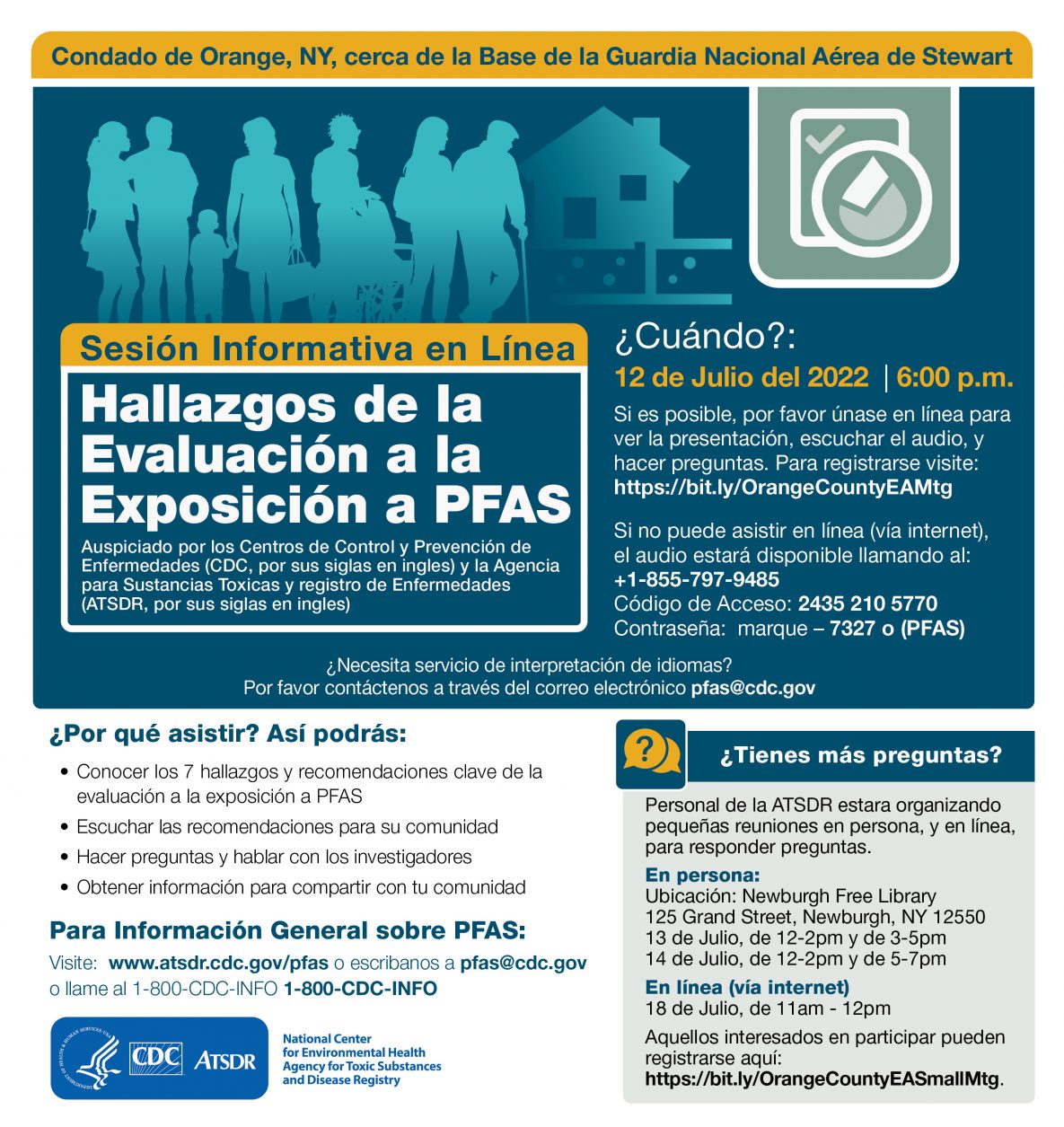Orange County (NY) near Stewart Air National Guard Base

In 2020, The Centers for Disease Control and Prevention (CDC) and the Agency for Toxic Substances and Disease Registry (ATSDR) conducted an exposure assessment (EA) in Orange County, New York, near Stewart Air National Guard Base (the Base). CDC and ATSDR sent the individual test results to participants and released summary results to the community in May 2021. The per- and polyfluoroalkyl substances (PFAS) exposure assessment report [PDF – 2 MB] was released in June 2022.
Why did we select the Orange County EA site?
When selecting EA sites, ATSDR considered the extent of PFOA and PFOS contamination in drinking water supplies, the duration over which exposure may have occurred, and the number of potentially affected residents. Orange County was one of several sites nationwide identified with PFAS drinking water contamination from use of products such as aqueous film forming foam (AFFF).
The Base previously used AFFF containing PFAS for its firefighter training. It is not known when the Base first used the foam, but it is believed to have started as early as the 1980s. Over time, the PFAS from the AFFF entered the ground, moved into the groundwater to offsite locations, and affected the City of Newburgh’s surface water source, Washington Lake. To reduce levels of PFAS in drinking water, City of Newburgh authorities stopped using Washington Lake as its water source in May 2016, and New York City’s Catskill Aqueduct has served as the primary water supply since that time.
Based on the information ATSDR has reviewed, the City of Newburgh drinking water supply currently meets or is below the U.S. Environmental Protection Agency’s (EPA) 2016 health advisory (HA) and state public health standards for PFAS in drinking water.
How was the testing conducted?
ATSDR invited randomly selected households to participate in the EA. To be eligible to participate, household residents must have (1) lived within the sampling frame and received their drinking water from the City of Newburgh’s public drinking water system for at least 1 year before May 2, 2016 (these residents have the greatest likelihood of past exposures to PFAS via the city’s drinking water supply), (2) been greater than three years old at the time of sample collection, and (3) not been anemic or have had a bleeding disorder that would prevent giving a blood sample. Households with private wells were not eligible for participation. Measuring PFAS in the blood of people from randomly selected households allows us to estimate exposure from consumption of public drinking water for the entire community in the affected area, even those who were not tested.
Results
In May and September 2021, CDC and ATSDR released a summary of the biological and environmental test results, respectively. The full report was released June 28, 2022 and a summary of the report’s findings is presented below. The full report is available here [PDF – 2 MB].
ATSDR
analyzed data from
59
people,
(58 adults and 1 child)
from
48
households
Everyone completed a questionnaire.
Most people provided blood and urine samples.
ATSDR collected samples of tap water and dust from some homes.
ATSDR sent each participant their individual biological and environmental results in May and September 2021, respectively.
Key Takeaways
- Average age-adjusted levels of PFHxS in the blood of the Orange County EA site participants were three times national levels. Other PFAS were not higher than the national average or were detected too infrequently to compare to national averages.
- Elevated blood levels may be linked with past drinking water contamination.
- Some demographic and lifestyle characteristics were linked with higher PFAS blood levels.
- All tap water samples collected during the EA in 2021 met the EPA’s 2016 HA and New York State public health standards for PFAS in drinking water.
The average blood levels of PFHxS in Orange County EA site participants were higher than average levels nationwide.
Of the seven PFAS tested at the Orange County EA site, six PFAS were detected in more than 84% of the blood samples collected: PFHxS, PFOS, PFOA, PFNA, PFDA, and PFUnA.
Since 1999, the National Health and Nutrition Examination Survey (NHANES) has measured PFAS levels in blood in the U.S. population. PFAS levels are shown to be age dependent and tend to increase with age in part due to longer periods of exposure. ATSDR adjusted blood levels of study participants in the Orange County EA site community for age to enable meaningful comparison to the NHANES dataset. After adjustment, PFHxS levels remained higher than levels nationwide. Age-adjusted averages are more representative of the Orange County EA site community.

Elevated blood levels of PFHxS in Orange County EA site participants may be linked with past drinking water contamination.
PFHxS, PFOS, and PFOA were detected in the City of Newburgh water supply as early as 2013. Because no data are available prior to 2013, we do not know if contamination began earlier. In 2016, the City of Newburgh reduced concentrations of PFAS below U.S. EPA health advisory levels by switching its water source. There were four years and five months between the reduction of exposure via contaminated drinking water and the collection of the EA blood samples. Because of the long half-lives of PFHxS, PFOS, and PFOA in the human body, past drinking water exposures may have contributed to the EA participants’ blood levels. PFHxS has the longest estimated half-life of the three compounds, which may contribute to why it exceeded the national average by the largest margin.
Long-time residents had higher PFHxS levels.
Taken together, the data suggest that
past drinking water exposure contributed to the elevated blood levels of PFHxS observed in the Orange County EA participants.
Blood levels of PFHxS, PFOS, and PFOA changed with participant age.
In females, blood levels for these compounds increased by 2.4% to 5.4% for every year of participant age.
In males, blood levels for these compounds decreased by 0.58% to 1.3% for every year of participant age.
Males had higher blood levels of PFHxS, PFOS, and PFOA than females. The difference between males and females was larger in younger people.
Residents who reported consuming locally grown fruits or vegetables had 44% higher PFUnA blood levels than those who did not.
Fact sheets and Report
- PFAS Exposure Assessment, Orange County, New York: Report [PDF – 2 MB] (6/29/2022)
- PFAS Exposure Assessment, Orange County, New York: Report Appendix [PDF – 1 MB] (6/29/2022)
- PFAS Exposure Assessment, Orange County, New York: Report Consumer Summary [PDF – 451 KB] (6/29/2022)
- PFAS Exposure Assessment, Orange County, New York: Community-Level Summary Results Fact Sheet
CDC and ATSDR invite all residents in the Newburgh, Orange County, NY EA site area to attend a virtual information session to learn more about the results of the PFAS exposure assessment. Experts will also answer community questions.
When: July 12, 2022
Time: 6:00 p.m.
To register, go to: https://bit.ly/OrangeCountyEAMtg
ATSDR staff will also host small, in-person and online meetings to answer questions.
ATSDR staff are available in-person at the Newburgh Free Library (124 Grand Street Newburgh, NY 12550) on July 13th, from 12pm-2pm and 3pm-5pm; and on July 14th, from 12pm-2pm and 5pm-7pm to answer community questions.
Staff are offering an additional virtual meeting on July 18th, from 11am-12pm.
Those interested in participating in the small, in-person and online meetings are encouraged to sign up here: https://bit.ly/OrangeCountyEASmallMtg


